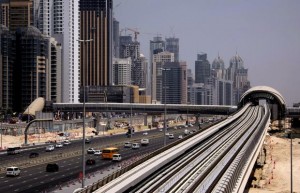By Tamara Walid, Reuters www.vancouversun.com
Thousands it was built for now gone dubai’s metro, the first in the Gulf Arab region, opened to the public on Thursday, creating a buzz in a city that has had little to celebrate in the aftermath of the global financial crisis.

Planned at the height of Dubai’s boom and launched in a glitzy ceremony telecast across the Gulf, the light rail transit system comes as the emirate grapples with slowing growth and a depleted population as thousands of jobs have been cut.
“I’ll never take my car ever again. . . . This is a dream come true,” said an Emirates citizen.
The metro is another milestone for Dubai, which made a name for itself in the heydays of an oil-fuelled boom with lavish infrastructure projects such as the world’s tallest tower and man-made islands shaped like palms.
Dubai’s ruler, Sheik Mohammed bin Rashid al-Maktoum, inaugurated the metro on Wednesday night amid fireworks and a live telecast across the Gulf.
“This is an achievement for all Arabs,” he said.
But it may have come too late to cope with the congestion it was built to alleviate and is unlikely to see the ridership levels–3,500 passengers per hour–projected by the transport authority for the first stage of the project.
The first segment of the light intra-city rail, the Red Line, opened Thursday with 10 out of 29 stations operational. More stations will open in clusters in coming months and a second line is expected to be operational next year.
While Dubai focused on developing its property, tourism and banking sectors, becoming the trade and tourism hub of the Middle East, its public transport lagged far behind.
The city still relies heavily on gas-guzzling cars, with an average of three cars per family, while public transport, mainly buses, struggles to service low-income workers who make up the majority of the population with average salaries of 800 dirhams ($217.8) a month.
The metro, which is estimated to cost 28 billion dirhams ($7.62 billion), or 80 per cent more than originally planned, is expected to become the world’s longest driverless rail system.
The cost of the metro–up to $1.76 a ride–may put off some while the idea of crossing a scorching parking lot in Dubai’s summer heat when temperatures near 50 Celsius will dissuade others.
Many residents, making up Dubai’s nouveau riche middle class, enjoy driving–or being driven — in luxury vehicles and the metro may come to be seen as the blue-collar workers mode of transport.
After the opening ceremony, people scrambled to get their cars from the valet service.
Amid the roar of luxury sports cars, another VIP guest waiting for his Mercedes-Benz to be brought down, mused on the latest innovation in Dubai.
“The metro’s impressive, but it’s a project for the future.”
















